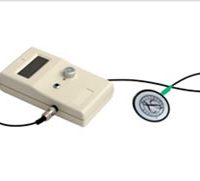PSYCHO-PERISTALSIS
Extract From “The History of An Infantile Neurosis”, p. 76
“I then had the satisfaction of seeing his doubt dwindled away, as in the course of the work his bowel began, like a hysterically affected organ, to “join in the conversation”.
Sigmund Freud (1918)
Extract From “Psycho-Peristalsis – the physiological working-out mechanism” Lectures

Loudspeaker stethoscope with Littman (medical standard) chest-piece.
“This led me to the thought that there must be another, more subtle mechanism for physiological abreaction of nervous energy, as yet unknown. I saw patients responded best when they had diarrhoea and stomach reactions. This led me to the conclusion that diahorrea was not only a reaction to fear but possibly could be an abreaction mechanism.
Soldiers in battle have diarrhoea and this diarrhoea is not only a reaction but an explosive abreaction of excessive nervous tension. The same happens when chickens are afraid, and with all creatures when they are nervous.
This thought led me to the hypothesis that if we have a physiological intestinal abreaction mechanism for nervous energy, diarrhoea would not be the only way of release. There must be another, silent and more subtle mechanism for getting rid of emotional tension. If this were related to intestinal contractions, the hypothesis would follow that the body had its own way of abreacting tension, by milder working out contractions.
Pavlov showed that a dog with normal digestive operation cramps his stomach when a cat comes in the room. We cramp our intestines when we feel rage or other strong emotions. When we relax, we relax our intestines too and the digestive work can begin.
Usually, intestinal contractions are related to digestion, but intestinal research has shown that there are two types of stimulus bringing about intestinal contractions, the one being intestinal content; the other is stimulated by the pressure of distention in the intestinal walls and this has a known function. This distention pressure is in my view related to the ‘working out’ of nervous energy and here we come to Wilhelm Reich’s concept of stasis.”
Gerda Boyesen
Clinical Psychologist Gerda Boyesen describes “psycho-peristalsis” as an “actual healing mechanism” in the body that is situated in the viscera, and specifically in the gastro-intestinal tract.
This mechanism is the link ‘between psyche and soma’ and is the basis for healing in the human body and mind. Sounds from the gut can often be heard naturally, during a talking or vegetotherapy session at times of insight, after expression and resolution or when there is an “aha” moment in the process. More usually, in a biodynamic session we listen to these sounds via the stethoscope and the sounds are used as a form of biofeedback.

Exit treatment on the hand – with loudspeaker stethoscope
Further, by actually monitoring the parasympathetic function of the autonomic nervous system (via the loudspeaker stethoscope) the biodynamic practitioner can assist the client’s body to progressively clear their cells and tissues of the residual hormonal (bio-chemical) by-products of stress.
This process of physical cleansing and detoxification simultaneously assists the client to clarify negative attitudes and harmful beliefs that have led to mental disturbance and dysfunction and be open to fresh ideas.
Psycho-peristalsis is the means whereby the interruption to the flow of life energy in the body and mind is organically re-connected.